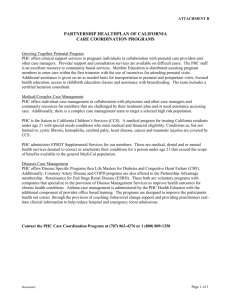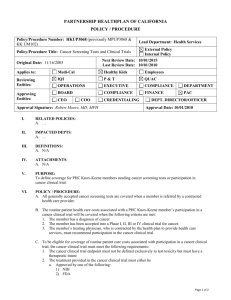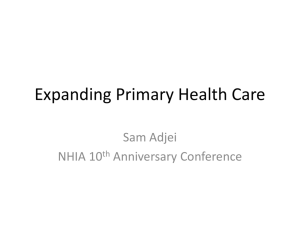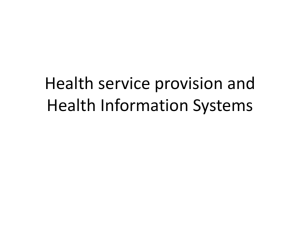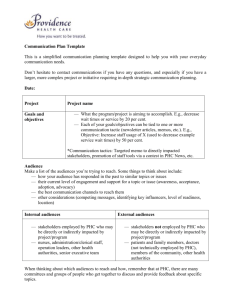Paradigms for Primary Health Care
advertisement
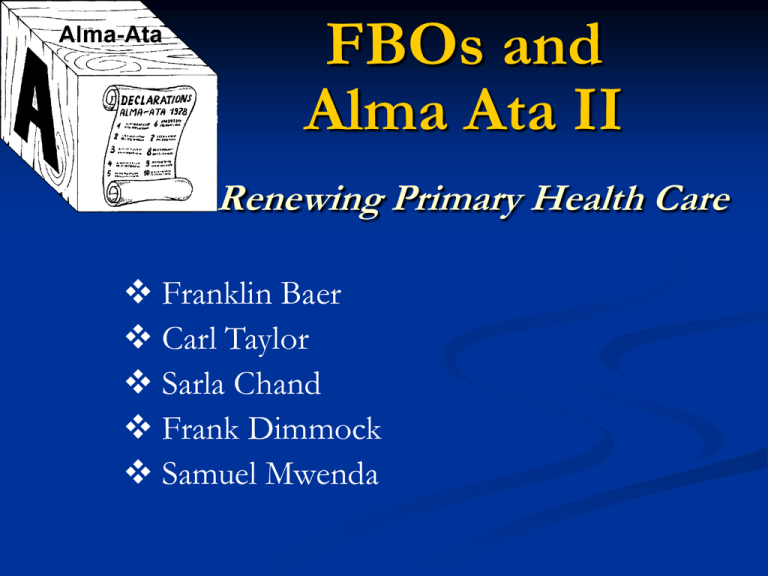
FBOs and Alma Ata II Renewing Primary Health Care Franklin Baer Carl Taylor Sarla Chand Frank Dimmock Samuel Mwenda Renewing PHC in the Americas Create a vision and renewed sense of purpose for health systems development for a Primary Health Care-Based Health System. 1) Review the legacy of Alma Ata 2) Articulate a strategy for PHC renewal 3) Lay out steps to achieve this vision. Various Approaches to PHC (and the need for complementarity) Approach Emphasis Alma Ata A strategy for organizing healthcare “comprehensive PHC” systems & society to promote health Selective PHC Primary care Health & Human Rights approach Specific set of health service activities geared towards the poor Level of care in a health services system A philosophy permeating the health and social sectors The renewed definition of PHC Focusing on the health system as a whole Include public, private, and non-profit sectors Recognize PHC as more than provision of health services: Differentiate values, principles and elements Highlight equity and solidarity; Incorporate sustainability and a quality orientation. Specify measurable organizational & functional elements Recognize dependency on other health system & social processes Recognize need for each country to design their own strategy Role of FBOs in renewing PHC? No mention of FBOs, Faith, or church 1 mention of missionaries & Christian (Annex C) The Christian Medical Commission was created by medical missionaries working in developing countries. They emphasized training of village health workers 1 mention of private and non-profit sectors Renewing PHC should include public, private, and nonprofit sectors; Faith-Based Health Care Public Private Renewing PHC: Back to the Basics “A” is for Alma Ata The Alma Ata Conference (1978) defined PHC : 10 Declarations of Alma-Ata The people have the right and duty to participate individually and collectively in the planning and implementation of their health care. 8 Essential Components of PHC 4 A’s of PHC (Accessible, Available, Acceptable, Affordable) 3 Aspects of PHC (Curative, Preventive & Promotion) Community-Based & Congregational-Based • • • • • • Role of the Church in Community-based Health Care Community Health Global Network Working Group Evidence-Based study of Community-Based PHC Community Health Evangelism (CHE) Care Groups Training for Transformation, Building our Lives Building Integrated Health Systems A 3-D conceptual model of a comprehensive health system based on PHC (1988, Smith & Bryant): First Dimension: PHC Program elements Second Dimension: Functional Infrastructure Third Dimension: Level of Service delivery Conceptual Model of a Comprehensive Integrated Health System FBOs & PHC Health Systems 1st: PHC Program Elements Risk of becoming labeled as being “single issue” Water & Sanitation WIMEN & CHD Immunizations Support Systems Mother & Child Care (&FP) ??? Essential Drug Systems Essential Drugs Human Resource development Nutrition & Food 3rd: Health System Levels & Curative Care Family & Home Health Education Community-Based (& Congregation-Based) Disease Control 2nd: Health Facility-Based Health Districts National Level (FBO Health Networks) FBOs & Renewing PHC 1) Review the legacy FBOs and Alma Ata 2) Articulate a strategy for FBO contributions to renewing PHC 3) Lay out steps to achieve this vision FBOs and Alma Ata II Renewing Primary Health Care Franklin Baer Carl Taylor Sarla Chand Frank Dimmock Samuel Mwenda Medical Missions’ transition to Health Missions Christian Medical Commission of the World Council of Churches in Geneva 1960’s Tubingen Conferences (Martin Scheel) Key Leaders: Jack Bryant, Jim McGilvary, David Jenkins, Anthony Bloom, Hakan Hellberg, David Morley, Fred Sai, Nita Barrow, Caroll Behrhorst Surveys of ripple effect of health impact from hospitals Need to do more prevention and behavior change Christian Medical Commission Journal “Contact” pioneered the early explorations of what we now call Community Based Primary Health Care Rockefeller to WHO: Christian Connections Ding Xian: John B Grant, Jimmy Yen, CC Chen Second Generation Projects: Hydrick in Jogjakarta, Indonesia Eloesser in Chile and China Kark in Pholela, South Africa Third Generation Projects: Narangwal Jamkhed Christian Medical Commission projects (Litsios, AJPH) Health by the People (Newell, WHO) Alma Ata Conference in 1978 (Halfdan Mahler, WHO) Comprehensive vs Selective (top-down vs bottom-up) FBOs and Alma Ata II Renewing Primary Health Care Franklin Baer Carl Taylor Sarla Chand Frank Dimmock Samuel Mwenda Faith- Based Maternal & Newborn Health Care Programs 1. Community-based - India ,Jamkhed, CRHP - Mozambique, World Relief, Care Groups 3. National faith-based health networks - 2. Congregational Health Model - Malawi, CCAP Malaria Prevention Program Uganda , UPMB, UMMB Kenya, CHAK Tanzania, CSSC 4. District Health Co-Management - DR Congo, ECC-DOM, the SANRU Program 1. Comprehensive Rural Health Project Jamkhed, India YEAR Infant Mortality Crude Birth Rate 1971 176 2004 India 2004 24 62 40 18.6 23.9 Safe delivery Family Planning 5.0% 99% <5.0% 99% <1.0% 68% 64% 43% 41% Children < 5 DPT/Polio Malnutrition (weight for age) Integration, Equity and Empowerment with leadership of village health workers (VHWs). Maternal Hlth Antenatal Care Since 1970 Jamkhed has empowered communities to take health into their own hands through principles of 5% 99% 40% 5% 70% 47% Christian principles of justice and service provide an alternative model of society to the inequitable Indian caste system. The government of India started the National Rural Health Mission (NRHM) chaired by the Prime Minister. NRHM has adopted the village health worker model of Jamkhed for this country wide program. www.jamkhed.org 2. Congregational Malaria Prevention Program 26 out of 150 CCAP congregations in hard to reach areas of Northern Malawi trained women to: 1) Deliver malaria prevention and treatment messages, and 2) To provide/sell mosquito nets and insecticide. The Synods of Livingstonia & Nkhoma, Presbyterian Church of Central Africa, Malawi 3. National faith-based health networks UPMB/UMMB/UCMB – Interfaith, public & PNFP Contribution of Christian Health Networks to the National Health Sector in Select African Countries FBO • • • • 100 90 80 70 60 50 40 30 th o e so Le ba bw m bi a Za a aw i M al an i da nz Ta ga n ny a n da Su Ke U Zi m So ut h on go na RC D G ha ria 20 10 0 Li be Facilities This project trained providers, CORPS and mobilized Religious Leaders to promote: MoH Uptake of Intermittent Preventive Treatment for Malaria Use of ITNs among pregnant women Capacity among providers to deliver focused ANC services Pregnant women coming early (first trimester) for ANC % pregnant women receiving IPT1 increased 43% to 94% % pregnant women receiving 1st IPT2 increased 63% to 76% 4. District Health systems development and Management SANRU’s integrated and systems strengthening approach resulted in major achievements in maternal & newborn care: Prenatal Care increased to 80% www.sanru.org Assisted births increased from 45% to 65% SANRU’s health system strengthening program strengthens PHC interventions and encourages co-management of health zones via FBO health networks. Challenge for Faith Communities Save pregnant women and babies from preventable deaths Through Integrated, comprehensive community health programs Enable capacity building of partners in Africa, Asia and LA/C FBOs and Alma Ata II Renewing Primary Health Care Franklin Baer Carl Taylor Sarla Chand Frank Dimmock Samuel Mwenda FAITH-BASED HEALTH NETWORKS IN AFRICA Renewing the focus on Primary Health Care AFRICA Christian Health Associations active CHAs networks evolving networks History and Coverage of Faith-based Health Services Appreciating Religious Health Assets www.arhap.uct. ac.za Interfaith Health Program & Emory School of Public Health University of Cape Town – Dept of religious Studies University of Kwa Zulu Natal – Theology and Development Program University of Witwatersrand – Department of Sociology Research supported by the World Health Organization LESOTHO GIS / PGIS 2006 ARHAP Theory Matrix Religious Health Assets Religious Health Assets Intangible Tangible Prayer Resilience Health-seeking Behaviour Motivation Responsibility Commitment/Sense of Duty Relationship: Caregiver & “Patient” Advocacy/Prophetic Resistance - Physical and/ or Structural/Political Infrastructure Hospitals - Beds, etc Clinics Dispensaries Training - Para-Medical Hospices Funding/Development Agencies Holistic Support Hospital Chaplains Faith Healers Traditional Healers Care Groups NGO/FBO - “projects” Direct uum n i t Con Health Outcomes Individual (Sense of Meaning) Belonging - Human/Divine Access to Power/Energy Trust/Distrust Faith - Hope - Love Sacred Space in a Polluting World (AIC) Time Emplotment (Story) Manyano and other fellowships Choir Education Sacraments/Rituals Rites Of Passage (Accompanying) Funerals Network/Connections Leadership Skills Presence in the “Bundu” (on the margins) Boundaries (Normative) Indirect AIDSLink publication of the Global Health Council Community Realities in Africa Show FBO Partnership Key to Global Scale-Up Amidst the ongoing, often fierce, debate about the role of faithbased organizations (FBOs) in combating HIV/AIDS, a pilot study by the World Health Organization (WHO) and research partners in sub-Saharan Africa put to rest any doubts about the huge role played by faith communities in HIV care and treatment. It also reconfirmed the urgent need for partnerships with the public health community to achieve better health outcomes. With the rate of HIV treatment scale-up still averaging 50,000 new people per month, it is evident that government-sponsored or supported health services alone will not come close to reaching the target of universal access by 2010, which is another 6 or 7 million persons living with HIV. It is also evident from an examination of multilateral and bilateral funding programs and health policies that there is a failure to understand the influence of religion in African ‘health worlds.’ The study has recommended developing religious and public health literacy through formal courses, joint training, and shared materials to improve understanding. Time is of the essence for identifying religious health assets that could help to scale-up services, strengthen community support groups and religious entities, and further link them to nearby staterun hospitals, clinics and dispensaries. Further examination of the nature of intangible (spiritual encouragement, knowledge and moral formation) health assets is needed to more fully document the full extent of possibilities for religious health assets. There is an astonishing capacity possible in religious communities to greatly enhance health services, along with supporting people in their care, stimulating the will to live, and building communities. These are the added value of enrolling FBOs as full participants in the health system: Building communities, saving lives, and preventing the further spread of HIV. Rev. Canon Ted Karpf karpft@who.int SO…. What are we doing to support Christian partners in Africa, Asia, and elsewhere to be engaged and seize the opportunity to reach out within communities and through their Congregations ??? Christian Health Associations in Africa Bi-annual (almost) Assemblies • Siavonga, Zambia Conference 9/2001 • Nairobi, Kenya Conference 5/2003 • Mangochi, Malawi Conference 11/2004 BAGAMOYO CONFERENCE – Tanzania 2007 FBOs and Alma Ata II Renewing Primary Health Care Franklin Baer Carl Taylor Sarla Chand Frank Dimmock Samuel Mwenda BAGAMOYO AFRICA CHAs CONFERENCE 2007 STATEMENT OF COMMITMENT & RECOMMENDATIONS OF 18TH JANUARY 2007 Presented by Samuel Mwenda, CHAK Commitment agreed upon by the participating CHAs & partners The Bagamoyo conference reaffirmed the commitment to continue the healing ministry of Jesus Christ, serving the poorest of the poor and marginalised but also recognising the need to care for the carers in a biblical manner. In addition CHA’s will continue to work in partnership with churches, governments and other development partners. The Bagamoyo conference recognised that much progress has been made since the last conference in Malawi (2004). The TWG on HRH which was supported by IMA had facilitated this process. Strengthening a Support Platform for all CHA’s in Africa. A small rotating secretariat to improve networking and communication between CHA’s and associated organizations in Africa and elsewhere. CHAK agreed to host this secretariat for the initial 2-3 year time period. (TOR were to be developed) This secretariat would include a fulltime program officer who is fluent in both English and French The platform would facilitate discussion on specific issues concerning CHA’s and would also facilitate the preparation of the next meeting in 2009. A virtual platform for better communication would be hosted in such a network. IMA World Health and MMI would give technical assistance with other agencies contributing. …2.. The newly established office would also facilitate and promote the communication and collaboration between partners of the CHA’s such as the capacity project (IMA), EPN, AIDS initiatives, the Healing Study (DIFAEM), Medicus Mundi International, CCIH and other collaborative partners. WCC, IMA, MMI, DIFAEM, CCIH and other partners working with CHA’s will facilitate the lobbying and advocacy on behalf of CHA’s, FBO’s and Christian Health Services among churches and the international level. CHA’s committed to follow up on the HRH recommendations and the TWG would continue to support this process. Participants at the Bagamoyo Catholic Mission Cross which marks the entry point of Christianity into East Africa also marked the renewing of the CHAs commitment – Progress made TOR for the CHAs Platform secretariat and a work plan were developed by CHAK Seed funds to start provided by WCC & Difaem A CHAs Platform Secretariat officer has been recruited and hosted by CHAK in Nairobi, Kenya Work plan implementation has started. The 1st Africa CHAs Bulletin is expected in June 2007 One issue of WCC’s Contact Magazine to focus on Way forward A CHAs Platform website needs to be created with a database of members and linkages to existing CHAs resources & websites Africa CHAs Platform needs to establish an active working relationship with CCIH and it’s members Africa CHAs Platform members, stakeholders, partners and collaborators are invited to contribute articles, information & news items for inclusion in the Bulletin New partners are invited to support the CHAs Platform with ideas, programs and resources towards making it a viable platform for engaging Africa Christian Health networks We should collectively begin putting our ideas together for the next Africa CHAs Conference which should be held in either Southern Africa or Western Africa in 2009 FBOs and Alma Ata II Renewing Primary Health Care 1) Review the legacy FBOs and AlmaofAta Create a vision and renewed sense purpose for2)health systems development for a Primary Articulate a strategy for FBO contributions to Health Care-Based renewing PHC Health System. 1) legacy of Alma FBO Ata visions. 3) Review Lay outthe steps to achieve 2) Articulate a strategy for PHC renewal I plan to promote integrated primary health 3) Lay out steps to achievecare this vision. as a strategy for strengthening health systems. --Dr Margaret Chan, WHO Director-General PAHO’s Next Steps: Building an International coalition Frame PHC renewal as a priority Develop concept of PHC-based health systems as a feasible and politically appealing policy option, Capitalize on the current windows of opportunity the recent the anniversary of Alma Ata, the Millennium Development Goals (MDGs) current focus on strengthening health systems.



